wheel FIAT STRADA 2011 Owner handbook (in English)
[x] Cancel search | Manufacturer: FIAT, Model Year: 2011, Model line: STRADA, Model: FIAT STRADA 2011Pages: 195, PDF Size: 3.68 MB
Page 140 of 195
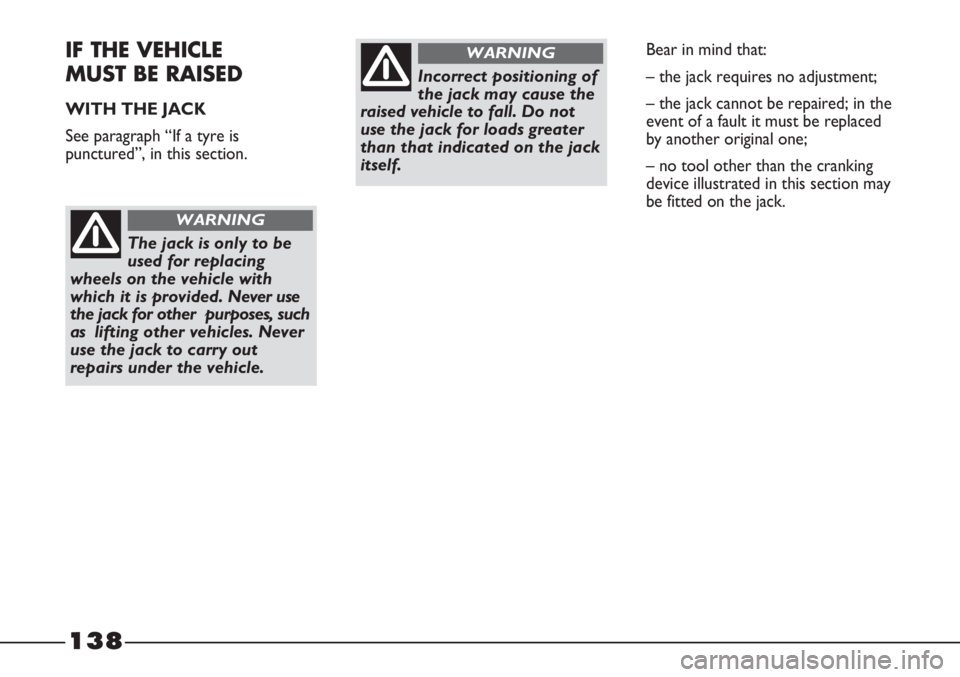
138
IF THE VEHICLE
MUST BE RAISED
WITH THE JACK
See paragraph “If a tyre is
punctured”, in this section.
The jack is only to be
used for replacing
wheels on the vehicle with
which it is provided.Never use
the jack for other purposes, such
as lifting other vehicles. Never
use the jack to carry out
repairs under the vehicle.
WARNING
Incorrect positioning of
the jack may cause the
raised vehicle to fall. Do not
use the jack for loads greater
than that indicated on the jack
itself.
WARNINGBear in mind that:
– the jack requires no adjustment;
– the jack cannot be repaired; in the
event of a fault it must be replaced
by another original one;
– no tool other than the cranking
device illustrated in this section may
be fitted on the jack.
Page 142 of 195

140
Before towing, turn the
ignition key to MAR
and then to STOP without
extracting it. If the key is
removed, the steering lock will
activate automatically and it
will be impossible to steer the
wheels.
WARNING
The tow hook must be
used exclusively for
roadside assistance operations.
You are allowed to tow the
vehicle for short distances using
an appropriate device in
accordance with the highway
code (rigid bar), to move the
vehicle on the road in readiness
for towing or transport via a
breakdown vehicle. The tow
hook MUST NOT be used to
tow vehicles off the road or
where there are obstacles
and/or for towing operations
using cables or other non-rigid
devices. In compliance with the
above conditions, towing must
take place with the two
vehicles (one towing, the other
towed) aligned as much as
possible along the same centre
line.
WARNING
fig. 149
F0X0132m
IF THE VEHICLE
MUST BE TOWED
The vehicle can only be towed at the
front.
The tow hook is supplied with the
vehicle.
It is located in the tool bag.
How to attach the tow hook:
1) Take the tow hook.
2) Remove the cover on the front
bumper fig. 149, prising it up using
a screwdriver in the notch on the
cover.
3) Fully tighten the ring on the
threaded pin.
Page 143 of 195
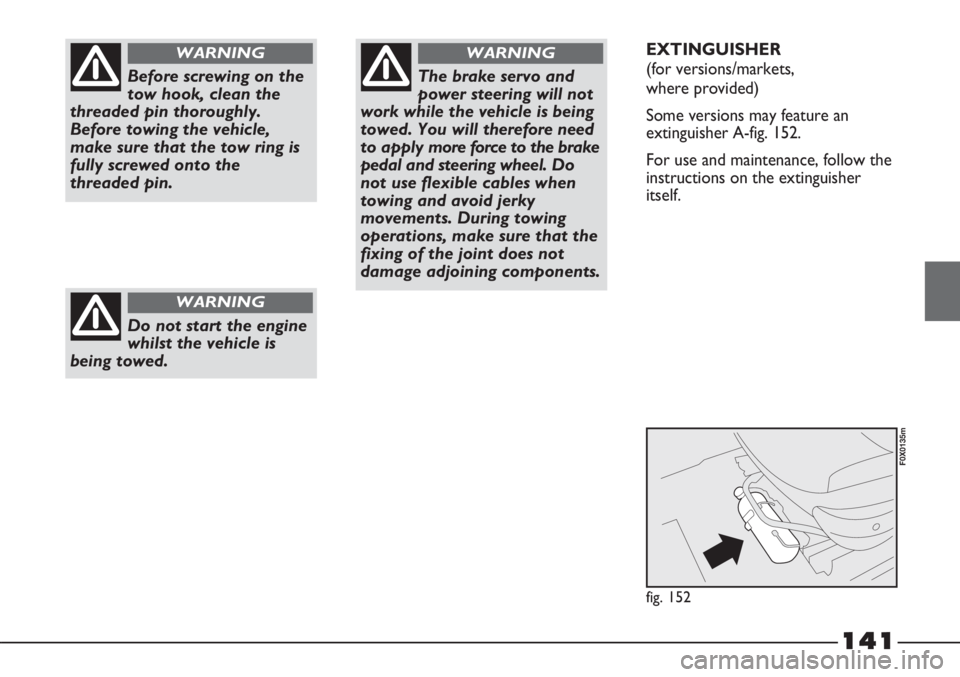
141
Before screwing on the
tow hook, clean the
threaded pin thoroughly.
Before towing the vehicle,
make sure that the tow ring is
fully screwed onto the
threaded pin.
WARNING
Do not start the engine
whilst the vehicle is
being towed.
WARNING
The brake servo and
power steering will not
work while the vehicle is being
towed. You will therefore need
to apply more force to the brake
pedal and steering wheel. Do
not use flexible cables when
towing and avoid jerky
movements. During towing
operations, make sure that the
fixing of the joint does not
damage adjoining components.
WARNINGEXTINGUISHER
(for versions/markets,
where provided)
Some versions may feature an
extinguisher A-fig. 152.
For use and maintenance, follow the
instructions on the extinguisher
itself.
fig. 152
F0X0135m
Page 159 of 195
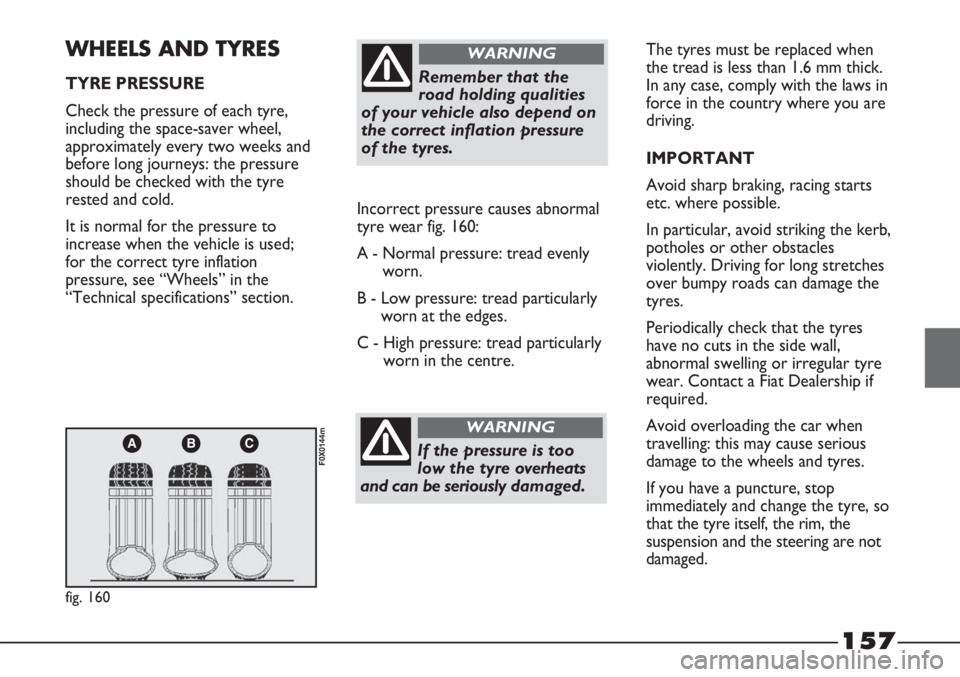
157
ABC
fig. 160
F0X0144m
WHEELS AND TYRES
TYRE PRESSURE
Check the pressure of each tyre,
including the space-saver wheel,
approximately every two weeks and
before long journeys: the pressure
should be checked with the tyre
rested and cold.
It is normal for the pressure to
increase when the vehicle is used;
for the correct tyre inflation
pressure, see “Wheels” in the
“Technical specifications” section.Incorrect pressure causes abnormal
tyre wear fig. 160:
A - Normal pressure: tread evenly
worn.
B - Low pressure: tread particularly
worn at the edges.
C - High pressure: tread particularly
worn in the centre.Remember that the
road holding qualities
of your vehicle also depend on
the correct inflation pressure
of the tyres.
WARNING
If the pressure is too
low the tyre overheats
and can be seriously damaged.
WARNING
The tyres must be replaced when
the tread is less than 1.6 mm thick.
In any case, comply with the laws in
force in the country where you are
driving.
IMPORTANT
Avoid sharp braking, racing starts
etc. where possible.
In particular, avoid striking the kerb,
potholes or other obstacles
violently. Driving for long stretches
over bumpy roads can damage the
tyres.
Periodically check that the tyres
have no cuts in the side wall,
abnormal swelling or irregular tyre
wear. Contact a Fiat Dealership if
required.
Avoid overloading the car when
travelling: this may cause serious
damage to the wheels and tyres.
If you have a puncture, stop
immediately and change the tyre, so
that the tyre itself, the rim, the
suspension and the steering are not
damaged.
Page 160 of 195
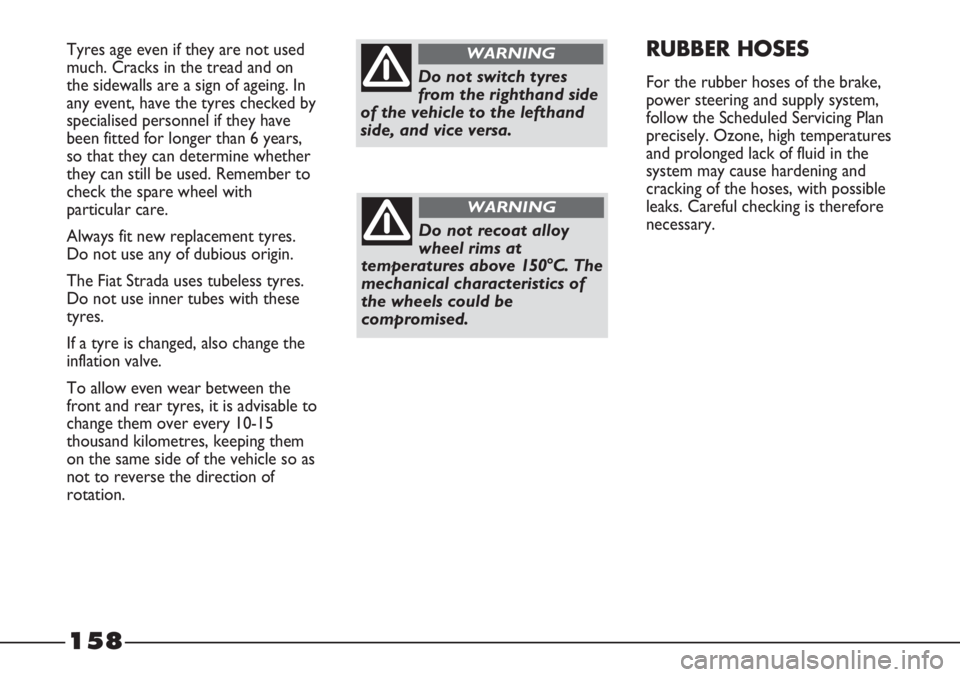
158
Tyres age even if they are not used
much. Cracks in the tread and on
the sidewalls are a sign of ageing. In
any event, have the tyres checked by
specialised personnel if they have
been fitted for longer than 6 years,
so that they can determine whether
they can still be used. Remember to
check the spare wheel with
particular care.
Always fit new replacement tyres.
Do not use any of dubious origin.
The Fiat Strada uses tubeless tyres.
Do not use inner tubes with these
tyres.
If a tyre is changed, also change the
inflation valve.
To allow even wear between the
front and rear tyres, it is advisable to
change them over every 10-15
thousand kilometres, keeping them
on the same side of the vehicle so as
not to reverse the direction of
rotation.RUBBER HOSES
For the rubber hoses of the brake,
power steering and supply system,
follow the Scheduled Servicing Plan
precisely. Ozone, high temperatures
and prolonged lack of fluid in the
system may cause hardening and
cracking of the hoses, with possible
leaks. Careful checking is therefore
necessary.Do not switch tyres
from the right hand side
of the vehicle to the left hand
side, and vice versa.
WARNING
Do not re coat alloy
wheel rims at
temperatures above 150°C. The
mechanical characteristics of
the wheels could be
compromised.
WARNING
Page 163 of 195
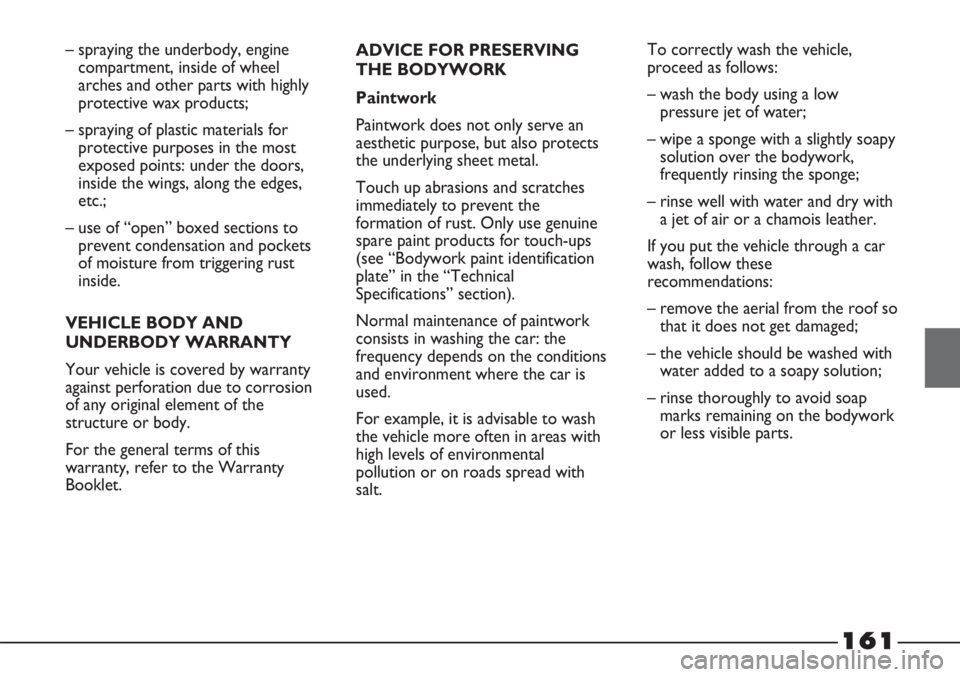
161
– spraying the underbody, engine
compartment, inside of wheel
arches and other parts with highly
protective wax products;
– spraying of plastic materials for
protective purposes in the most
exposed points: under the doors,
inside the wings, along the edges,
etc.;
– use of “open” boxed sections to
prevent condensation and pockets
of moisture from triggering rust
inside.
VEHICLE BODY AND
UNDERBODY WARRANTY
Your vehicle is covered by warranty
against perforation due to corrosion
of any original element of the
structure or body.
For the general terms of this
warranty, refer to the Warranty
Booklet.ADVICE FOR PRESERVING
THE BODYWORK
Paintwork
Paintwork does not only serve an
aesthetic purpose, but also protects
the underlying sheet metal.
Touch up abrasions and scratches
immediately to prevent the
formation of rust. Only use genuine
spare paint products for touch-ups
(see “Bodywork paint identification
plate” in the “Technical
Specifications” section).
Normal maintenance of paintwork
consists in washing the car: the
frequency depends on the conditions
and environment where the car is
used.
For example, it is advisable to wash
the vehicle more often in areas with
high levels of environmental
pollution or on roads spread with
salt.To correctly wash the vehicle,
proceed as follows:
– wash the body using a low
pressure jet of water;
– wipe a sponge with a slightly soapy
solution over the bodywork,
frequently rinsing the sponge;
– rinse well with water and dry with
a jet of air or a chamois leather.
If you put the vehicle through a car
wash, follow these
recommendations:
– remove the aerial from the roof so
that it does not get damaged;
– the vehicle should be washed with
water added to a soapy solution;
– rinse thoroughly to avoid soap
marks remaining on the bodywork
or less visible parts.
Page 166 of 195
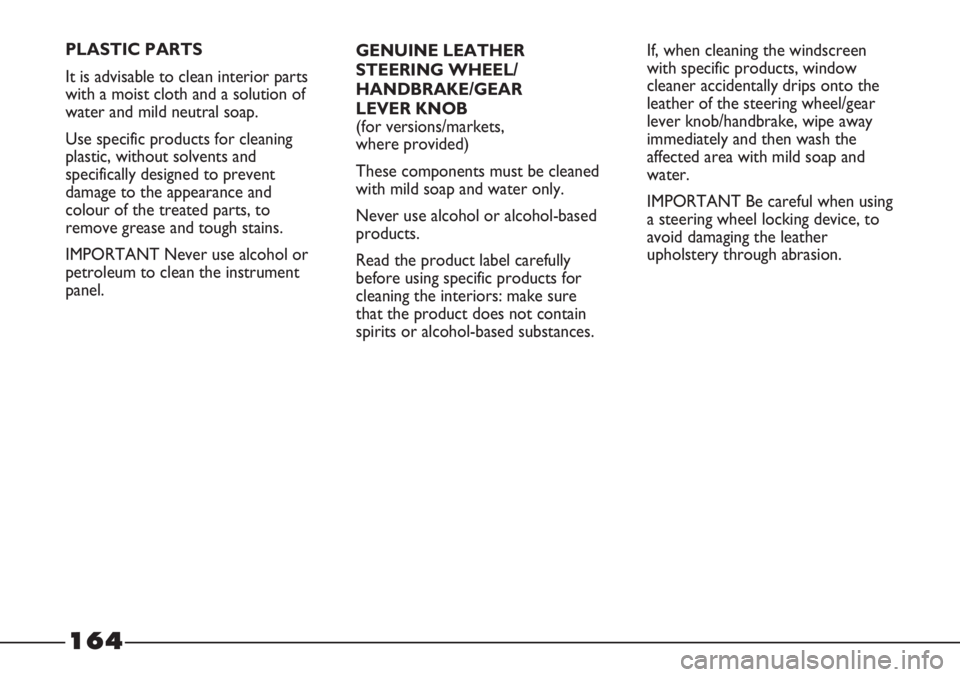
164
GENUINE LEATHER
STEERING WHEEL/
HANDBRAKE/GEAR
LEVER KNOB
(for versions/markets,
where provided)
These components must be cleaned
with mild soap and water only.
Never use alcohol or alcohol-based
products.
Read the product label carefully
before using specific products for
cleaning the interiors: make sure
that the product does not contain
spirits or alcohol-based substances.If, when cleaning the windscreen
with specific products, window
cleaner accidentally drips onto the
leather of the steering wheel/gear
lever knob/handbrake, wipe away
immediately and then wash the
affected area with mild soap and
water.
IMPORTANT Be careful when using
a steering wheel locking device, to
avoid damaging the leather
upholstery through abrasion. PLASTIC PARTS
It is advisable to clean interior parts
with a moist cloth and a solution of
water and mild neutral soap.
Use specific products for cleaning
plastic, without solvents and
specifically designed to prevent
damage to the appearance and
colour of the treated parts, to
remove grease and tough stains.
IMPORTANT Never use alcohol or
petroleum to clean the instrument
panel.
Page 171 of 195
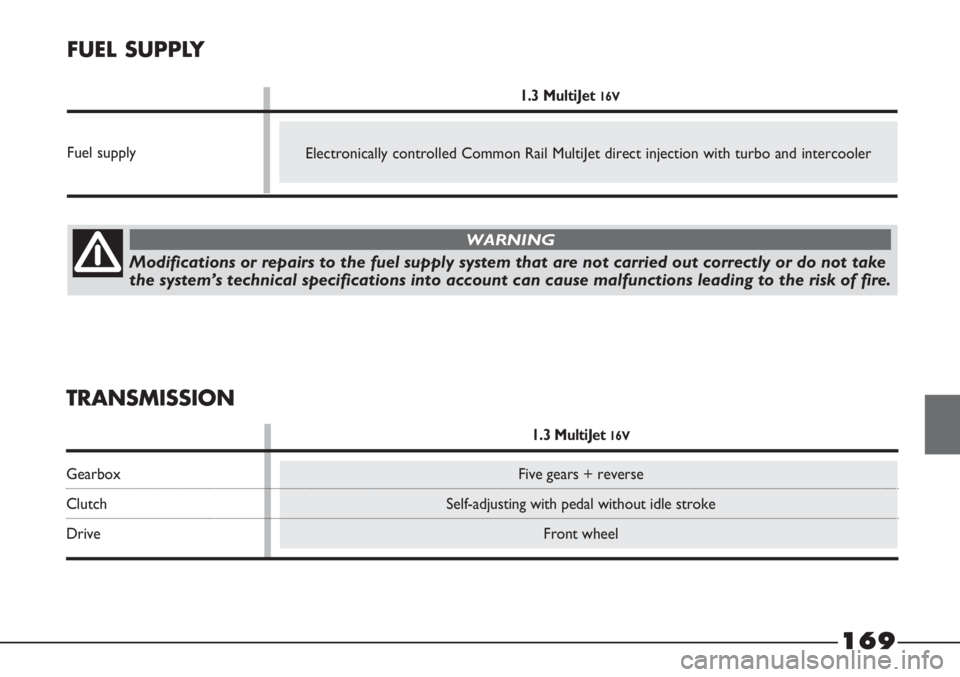
169
FUEL SUPPLY
1.3 MultiJet 16V
Fuel supply
TRANSMISSION
1.3 MultiJet 16V
Gearbox Five gears + reverse
Clutch Self-adjusting with pedal without idle stroke
Drive Front wheel
Electronically controlled Common Rail MultiJet direct injection with turbo and intercooler
Modifications or repairs to the fuel supply system that are not carried out correctly or do not take
the system’s technical specifications into account can cause malfunctions leading to the risk of fire.
WARNING
Page 173 of 195
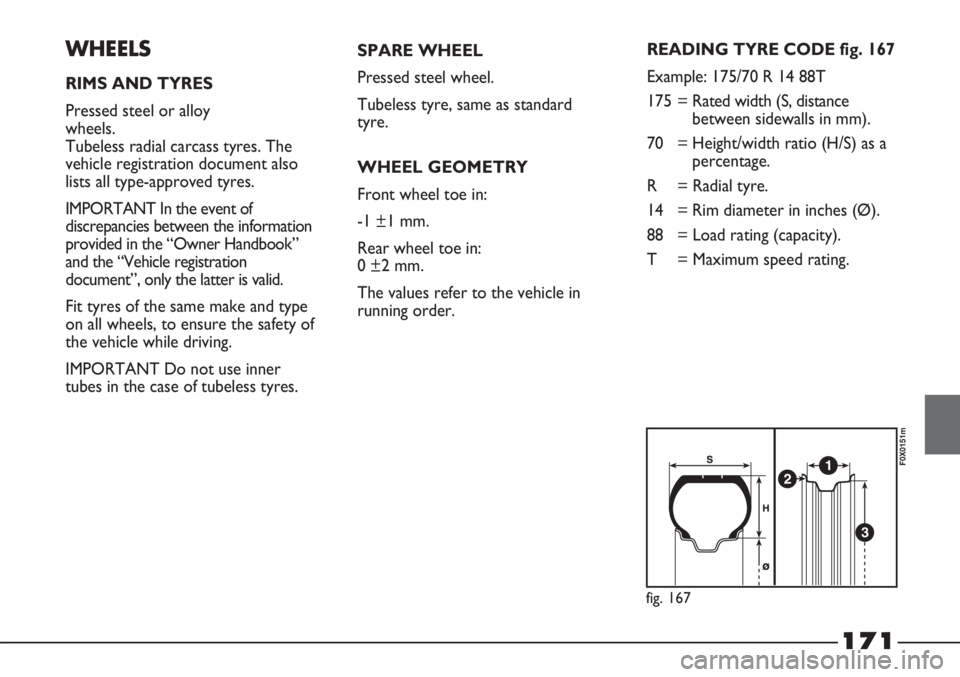
171
WHEELS
RIMS AND TYRES
Pressed steel or alloy
wheels.
Tubeless radial carcass tyres. The
vehicle registration document also
lists all type-approved tyres.
IMPORTANT In the event of
discrepancies between the information
provided in the “Owner Handbook”
and the “Vehicle registration
document”, only the latter is valid.
Fit tyres of the same make and type
on all wheels, to ensure the safety of
the vehicle while driving.
IMPORTANT Do not use inner
tubes in the case of tubeless tyres.
21
3
fig. 167
F0X0151m
SPARE WHEEL
Pressed steel wheel.
Tubeless tyre, same as standard
tyre.
WHEEL GEOMETRY
Front wheel toe in:
-1 ±1 mm.
Rear wheel toe in:
0 ±2 mm.
The values refer to the vehicle in
running order.READING TYRE CODE fig. 167
Example: 175/70 R 14 88T
175 = Rated width (S, distance
between sidewalls in mm).
70 = Height/width ratio (H/S) as a
percentage.
R = Radial tyre.
14 = Rim diameter in inches (Ø).
88 = Load rating (capacity).
T = Maximum speed rating.
Page 174 of 195

172
fig. 168
F0X0152m
70= 335 kg 81= 462 kg
71= 345 kg 82= 475 kg
72= 355 kg 83= 487 kg
73= 365 kg 84= 500 kg
74= 375 kg 85= 515 kg
75= 387 kg 86= 530 kg
76= 400 kg 87= 545 kg
77= 412 kg 88= 560 kg
78= 425 kg 89= 580 kg
79= 437 kg 90= 600 kg
80= 450 kg 91= 615 kg
Q= up to 160 km/h.
R= up to 170 km/h.
S= up to 180 km/h.
T= up to 190 km/h.
U= up to 200 km/h.
H= up to 210 km/h.
V= up to 240 km/h.
QM + S= up to 160 km/h.
TM + S= up to 190 km/h.
HM + S= up to 210 km/h.
Maximum speed rating
Maximum speed rating for snow tyres
Load rating (capacity)RIM PROTECTOR TYRES
fig. 168
DO NOT fit wheel hub
caps when using
integral hub caps fixed (with
springs) to the steel rim and
after sale tyres provided with
Rim Protector.
Use of unsuitable tyres and
hub caps may cause sudden
loss of tyre pressure.
WARNING